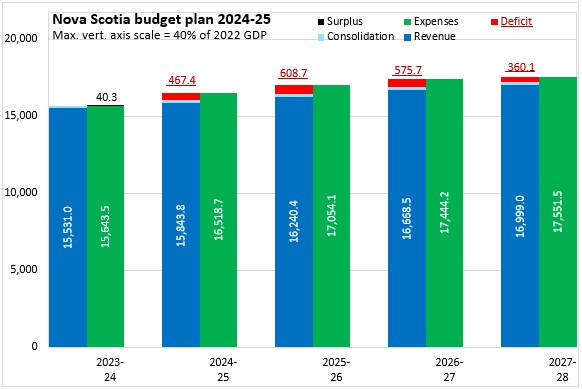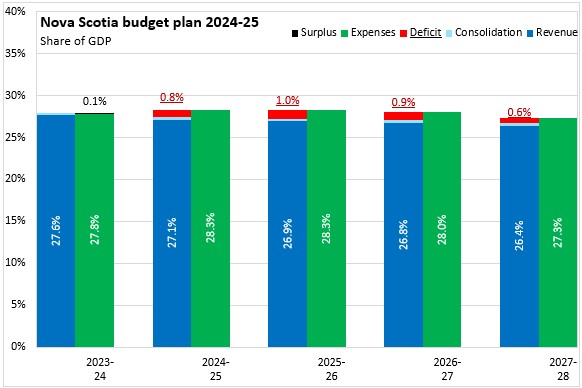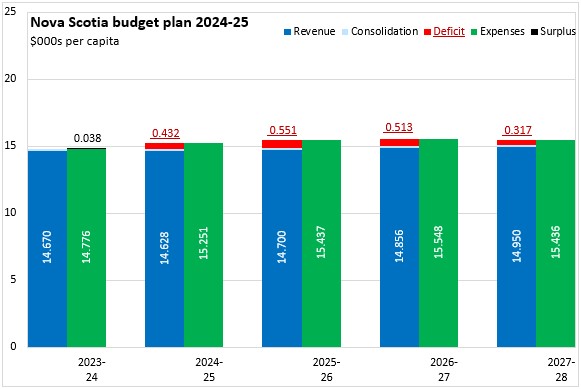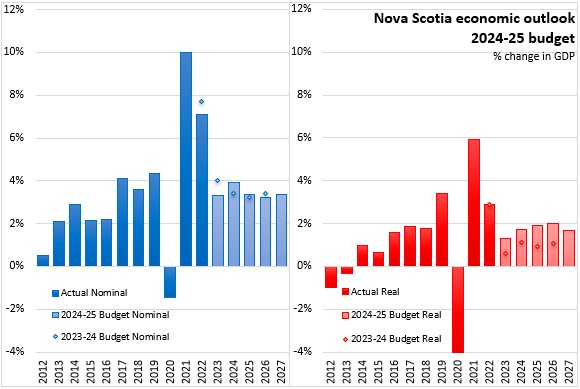The Economics and Statistics Division maintains archives of previous publications for accountability purposes, but makes no updates to keep these documents current with the latest data revisions from Statistics Canada. As a result, information in older documents may not be accurate. Please exercise caution when referring to older documents. For the latest information and historical data, please contact the individual listed to the right.
<--- Return to Archive
For additional information relating to this article, please contact:
February 29, 2024NOVA SCOTIA BUDGET 2024-25 The Province of Nova Scotia has released its provincial budget for 2024-25.
After posting a small surplus ($40.3 million) in 2023-24, Nova Scotia's 2024-25 budget projects a deficit of $467.4 million. The deficit is projected to widen to $608.7 million in 2025-26 before narrowing to $575.7 million in 2026-27 and $360.1 million in 2027-28.
Nova Scotia's revenues are projected to grow by 2.0% from the 2023-24 forecast to the 2024-25 budget estimate while expenditures grow by 5.6%. In 2025-26 revenue growth is projected to quicken to 2.5% while expenditures grow by 3.2%. In 2026-27, revenue growth of 2.6% exceeds expenditure growth of 2.3%. In the last year of the 2024-25 fiscal plan, revenue growth (+2.0%) again outpaces expenditure increase (+0.6%).

Measured as a share of GDP, the footprint of government in the Nova Scotia economy is projected to peak at 28.3% in both 2024-25 and 2025-26 before contracting to 27.3% by 2027-28. The Nova Scotia budget deficit amounts to 0.8% of GDP in 2024-25. The deficit is projected to remain stable as a share of GDP in the next three years before contracting slightly to 0.6% in 2027-28.
Nova Scotia's net debt is projected to rise from 33.3% of GDP as of the latest 2023-24 forecast to 34.6% of GDP in 2024-25. Nova Scotia's fiscal plan anticipates that the net debt to GDP ratio will rise to 36.2% of GDP in 2025-26, followed by an increase to 37.5% of GDP in 2026-27 and to 38.4% of GDP in 2027-28.

The Nova Scotia government anticipates expenditures of $15,251 per capita in 2024-25 against revenues of $14,628 per capita. This leaves a deficit of $432 per capita. In the next two fiscal years, expenditures per capita are projected to rise slowly to before contracting in 2027-28. After falling slightly in 2024-25, Nova Scotia's per capita revenues are projected to rise slowly in each of the next three fiscal years.

Compared with last year's fiscal outlook, the Nova Scotia government expects more revenue as well as higher expenditures.

The net effects of higher revenue and higher spending result in a small surplus forecast in 2023-24 (though the 2023-24 Budget anticipated a deficit). The projected deficits for 2024-25 and 2025-26 are little changed from the fiscal plan in the 2023-24 Budget.

Revised data from Statistics Canada shows that Nova Scotia’s economic contraction in 2020 was deeper than previously estimated (-4.5 per cent), with a softer rebound in 2021 (+5.9 per cent). Real GDP growth slowed to 2.9 per cent in 2022.
In 2023, real GDP growth slowed to 1.3%. Household income was up on strong labour markets and growth in employee compensation. Household consumption and non-residential investment also contributed to growth in 2023. Investment in residential structures declined slightly in 2023 with notable weakness in the early part of the year. Exports are estimated to have fallen while rising imports were a drag on growth.
By 2024, Nova Scotia’s economy is expected to return to trend growth as the population continues to grow and inflationary pressures abate. Residential investment is expected to rebound in 2024 as construction picks up to meet growing housing needs. Exports are also expected to return to growth as global conditions normalize and inflation slows. In 2024, Nova Scotia’s real GDP is projected to grow 1.7 per cent while nominal GDP is projected to grow 3.9 per cent.
In 2025, Nova Scotia’s real GDP growth is projected to rise to 1.9 per cent, aided by an increase in major project spending. Nominal GDP growth is projected to be 3.3 per cent in 2025.
Demographic changes, geopolitical conflicts, and persistent inflation are significant risks to the economic outlook. The current projections are also sensitive to the effects of carbon pricing, timing of major project activities and labour and material supply constraints as well as extreme weather events. Data revisions have also proven a source of substantial uncertainty for Nova Scotia’s economic projections.

Key Measures and Initiatives
The Nova Scotia Budget for 2024-25 prioritizes supporting Nova Scotians, building communities, action for healthcare, building the workforce for more housing and a healthy economy. Key initiatives include:
Helping with the cost of living:
- Beginning January 1, 2025, indexing personal income tax brackets, the basic personal amount and certain non-refundable tax credits to Nova Scotia’s inflation rate. Tax reduction of $150- $160 million per year by 2028.
- $7.8 million more for additional actions to reduce child poverty, including: implementing an increased Nova Scotia Child Benefit, supporting young people leaving care at the age of 19 and expanding the EDGE Program, which prepares youth at risk for education and employment success
- $2.4 million more to create 500 new rent supplements, for a total of $69.2 million to help 8,500 households
Giving children a strong start:
- $18.8 million this year to launch a new lunch program for students in the public school system. The program will roll out over four years to an estimated $100 million annual investment by 2027–28
- $1 million for Cape Breton University’s accelerated and expanded teacher training
- $42.5 million more this year in child-care funding to lower fees for families, create more spaces and enhance after school care, fully recoverable from the Canada-Wide Early Learning and Child Care Agreement
- $12.3 million more to pay early childhood educators more and help stabilize and grow the workforce across the province
- $5.1 million more to increase rates and provide additional supports to foster children and their families, bringing the total annual funding to $16.7 million following the redesign initiative
- $5.8 million more to support the redesign of provincial preschool autism services
- $1.4 million more for Nova Scotia Hearing and Speech to significantly reduce wait times among preschoolers
Helping Nova Scotians meet their needs:
- $84.6 million for Supportive Housing Action and other programs to address homelessness, including: more supportive housing units, new supportive housing locations throughout the province, operational funding for shelter service providers, 100-bed shelter in Dartmouth, 70-bed shelter in Halifax, a new shelter exclusively for 2SLGBTQIA+ clients in Halifax as well as emergency shelter and support services for youth
- 102.3 million to take action on the Human Rights Remedy by making significant changes within the Disability Support Program and helping people with disabilities to better meet their needs, including: $53.3 million to deliver the new Income Assistance Disability Supplement – an additional $300 per month to about 15,000 people on income assistance who are not in the Disability Support Program, expanding community-based programming and individualized funding, adding new positions in the Disability Support Program to support clients and the implementation of changes related to the Remedy
- $16.4 million to support persons with disabilities living in institutions to transition into the community
- $7 million more to transition young adults with disabilities out of long-term care into the community
- $850,000 to raise the earned income exemption for Income Assistance clients
- $7.1 million more, for a total annual budget of $16.9 million, to provide increased, permanent funding for Transition Houses and Women’s Centres
- $2 million more, for a total of $2.5 million, for the Community Housing Growth Fund
- $2.8 million under the Action for Health plan to continue improving equity across the healthcare system
- $1.2 million for the Equity and Anti-Racism Strategy to support communities to address inequity and racism across the province
- Implement the Province’s first African Nova Scotian Justice Action Plan and advance collaborative work on an Indigenous Justice Action Strategy
Action for health care:
- $360.7 million more for Nova Scotia Health and IWK Health to deliver their programs and services to a growing population
- $184.3 million more to continue progress on the Action for Health plan, including:
- $59.2 million for primary healthcare initiatives, including the development of chronic disease care pathways and continuing to expand access to care options
- $19.8 million for initiatives to move patients through the healthcare system more quickly
- $19.6 million for cancer care and precision medicine improvements
- $11.3 million for improved access to surgeries by continuing to shorten the surgical and diagnostic waitlists
- $9.2 million for public health initiatives with a focus on early years and oral health programs
- $8 million for emergency care initiatives
- $36.2 million more for initiatives that move the province toward universal mental health and addictions care for all Nova Scotians, including:
- $10 million to establish an insured services program to support the delivery of publicly-funded mental health and addictions care
- $6.7 million more for community-based organizations delivering mental health, addictions and wellness services
- $7.6 million for the province’s mental health and addictions workforce
- $41.5 million to improve cancer care treatment
- $7.2 million to support Nova Scotians with diabetes, including $5.9 million for coverage of glucose monitors and $1.2 million to expand the insulin pump program
- $9.6 million more for direct benefits to help more people receive the care and support they need to stay home or return home following a hospital stay
- $9.6 million toward the plan to build 5,700 new and replacement long-term care spaces by 2032
- $4.7 million to provide long-term care homes with more funding for their food budgets
- $10.7 million more to help long-term care homes move toward the 4.1 hours of care standard
- $35.5 million to fund about 350 temporary and permanent long-term care spaces for people waiting to move from acute care to long-term care
- $10.5 million for investments in clinical digital workspaces in healthcare
- $75.6 million to continue building One Person One Record to enable a digitally supported patient-centered health system
Building the health care workforce:
- $48 million more for workforce strategies under the Action for Health plan
- $1.8 million for bursary incentives to encourage more people to enter the Primary Care Paramedic program
- $887,000 for training emergency medical responders
- $1.8 million this year for the Acadia University nursing program
- $637,000 more to continue the expanded nursing training programs
- $1.7 million more to continue supporting the expansion of 120 permanent seats and the one-time expansion of 180 seats in the NSCC Practical Nursing program
- $1.9 million for training medical laboratory technicians
Building health care infrastructure faster:
- $301.7 million for Halifax Infirmary expansion and Cape Breton Regional Municipality healthcare redevelopment projects
- $16.5 million for transition-to-community centres
- $108.3 million for construction and renewal of other hospitals and medical facilities, including projects in Amherst, Pugwash, Bridgewater, Yarmouth and the IWK Health Centre
- $32 million to repair and replace medical equipment
- $22 million to repair and replace medical facilities
- $20.2 million for various Action for Health plan capital initiatives
Skilled workforce:
- $46.4 million to grow the skilled trades workforce over the next three years
- $671,000 to increase participation and retention of women working in the skilled trades
- $340,000 more to create up to 3,200 additional paid internship opportunities for post-secondary students (through Mitacs)
- $27.2 million for the More Opportunity for Skilled Trades (MOST) tax refund program for workers under the age of 30 in high-demand occupations
- $8.6 million this year for community-based settlement service organizations that support newcomers
More housing:
- $80-$100 million estimated annually to rebate the 10% provincial HST on the new construction of purpose-built, multi-unit apartments
- $27.1 million for NSCC student housing projects at various stages of development
- $14.8 million this year for Nova Scotia projects to leverage funding from the National Housing Strategy 2022-25 Action Plan
- $5 million to expand the $28.6 million Affordable Housing Development Program to include student housing project proposals
- $3.6 million for a rapid housing initiative to develop new affordable housing units in Halifax
- $35.3 million to build new public housing units and for more repairs and maintenance to existing public housing
- $11.8 million for a new investment in modular public housing
Strategic infrastructure:
- $15 million this year ($47.3 million over 3 years), to expand access to cellular service across the province
- $5.5 million more for investments in cyber security
- $36 million for maintenance and repair of rural roads
- $55 million for gravel roads
- $483.3 million for major 100-series highway construction projects, and repaving and structure work
Clean, healthy economy:
- $36.7 million this year to advance Nova Scotia’s Climate Change Plan for Clean Growth:
- $3 million to develop a Clean Energy Fund
- $3 million to invest in the Clean Fuels Fund to support adoption of low-carbon and renewable fuels
- $1 million more to strengthen responses to coastal and inland flood risk
- $1.3 million more to allow more farmers to adopt clean technologies
- $650,000 to support climate change vulnerability assessments and adaptation plans for important fisheries and aquaculture infrastructure
- $1.3 million to invest in the Fisheries and Aquaculture Energy Efficiency Innovation Fund and a Climate Change Adaptation fund to help the sector reduce energy use and prepare for climate change
- $5.4 million to increase the amount of renewable energy by building at least 500 megawatts of new local renewable energy by 2026 and 50 megawatts of new community solar energy
- $1.5 million to advance the Green Hydrogen Action Plan
- $1.8 million more for ecological forestry implementation
- $8.3 million to upgrade the dykeland system
- $5.5 million more, for a total of $23.4 million, for the Payroll Rebate Program to attract innovative companies to the province
- $12 million for the Innovation Rebate Program for businesses to become more innovative, productive, competitive and sustainable
- $14.1 million for the Capital Investment Tax Credit for capital equipment for use in Nova Scotia
Nova Scotia Budget 2024-25
<--- Return to Archive